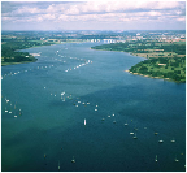Geoscience Reference
In-Depth Information
Harwich Harbour (
d1
) is a remarkable natural haven where the Stour and Orwell
valleys join, sheltered behind the coastal ridge that extends through Felixstowe to
Landguard Point (Fig. 254). Both of the main valleys have been carved, over long peri-
ods of changing conditions, by freshwater streams, and have been flooded recently by
the Flandrian rise in sea level since the last cold episode of the Ice Age.
Over the last 30 years, the Port of Felixstowe (north of
d1
; Fig. 255) has been
built on the flat ground behind the main coastal gravel barrier. The port is one of the
largest commercial developments in Southern England over the last few years, and has
been specifically engineered to handle international container transport.
FIG
253.
Looking northwestwards up the tidal estuary of the Lower Orwell (Fig. 247,
d1
).
The Orwell Bridge spans the estuary in the distance, carrying the
A14
trunk road to con-
nect the industrial Midlands with Felixstowe container port, and some of the buildings of
Ipswich can be seen beyond the bridge on the right-hand side of the picture. Orwell Park
House is in the middle distance on the right, on one of the steep 20-30 m high shoulders
typical of the drowned valleys of Suffolk, and the marina near Pin Mill is visible rather fur-
ther away on the left. (Photography held at Cambridge University Collection of Air Photo-
graphs, Unit for Landscape Modelling)
It is interesting to note that the Early Tertiary layer just below the surface between
Felixstowe and Ipswich yields phosphate mineral material (generally in the form of
coprolites) that has been commercially important in the past, and helped to develop the
fertiliser industry in this area. These coprolites are younger than the Early Cretaceous
coprolites of Cambridgeshire (Area 13), which also strongly influenced local commer-
cial development. The Early Tertiary London Clay has also yielded valuable materials
that have given rise to local industries.
The Harwich Cement Stone
came from one bed
- less than a metre thick - that occurs on the foreshore. On heating, this stone was
found to produce excellent Portland cement able to set strongly even in the presence
of water. The Harwich
Copperas Stones
, also collected from the foreshore, and often
originating as fossil wood, provided a source of sulphate important in tanning and the
dyeing of textiles.

